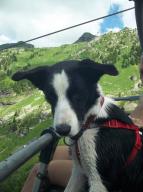
- Little Pants

- Cloth Nappy Addict

My Instant Lanolin Story (so far)
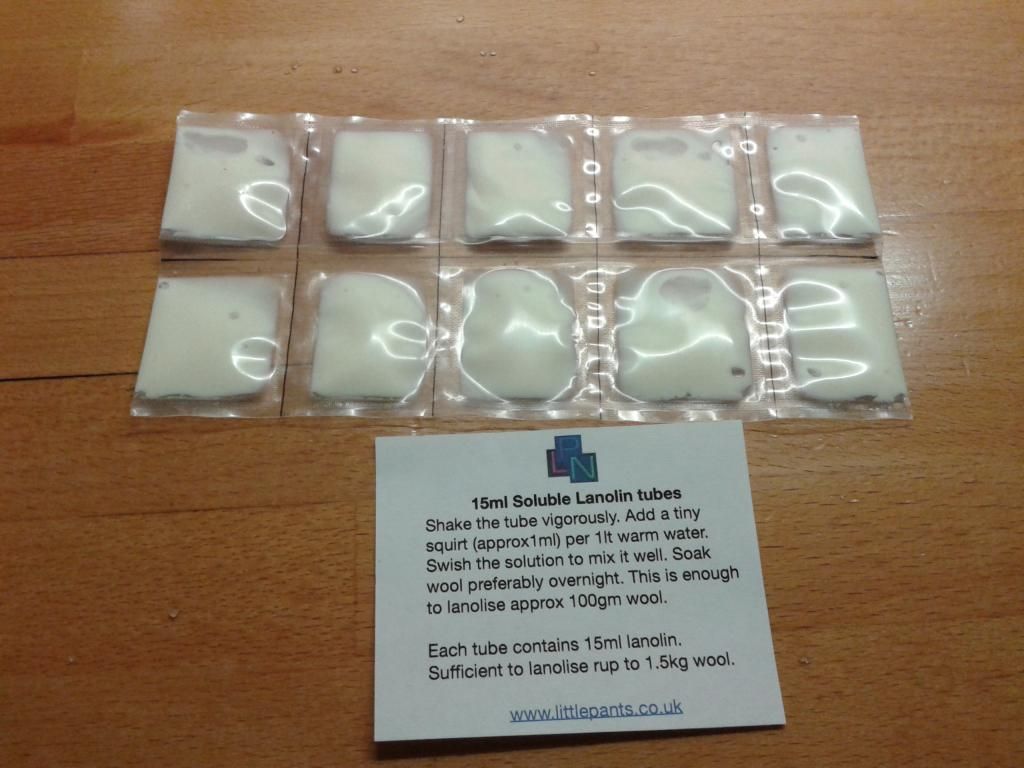
Being a woollly WAHM, I got really fed up with the mess and faff and waste involved each time I finished knitting a wool nappy cover for somebody. So I decided to experiment and see whether, if I made up a weekly batch of emulsified lanolin, it would keep and work OK from day to day. I found it did, and itwas soooo much easier than messing around emulsifying lanolin for each individual item.
I wondered if I made it thicker (to reduce storage space) and in larger quantities, just how long it would keep.So I made a fairly thick batch, and kept it in the fridge, just taking a tiny bit to lanolise, each time I finished a project. It kept perfectly until it was all used up, and what was even better was that, by fluke, this batch was just the right concentration - lanolised but not too sticky. So I made another even thicker badge, and this time kept it out of the fridge. Ditto - no problems.
After that I started in earnest to experiment with specific recipes, to see if I could find a consistently good recipe. After many documented attempts I finally perfected a recipe. This was the right consistency, and I could use a measured dose (I started with a small syringe left over from a pet medicine!) in a measured amount of water, which came out right every time - 1ml lanolin to 1lt warm water per 100gm wool.
Then I had one of thse brainwave moments. Why not see if any other wool nappy cover users would like to try it, so I could evaluate whether this might actually be worth selling.
Now I needed a storage/distribution solution. My first idea was tiny jars with a measuring syringe to measure the 1ml dose. This worked fine, and I asked some of my customers to try it out, and see if they liked it. Thus was an instant smash hit with them, without exception. So I decided to go full swing into selling this stuff to anyone who wanted it.
The small jars I had been using were not ideal, as they were the wrong size for sending by post - who was gong to pay £2.80 for a parcel containing just a small amount of lanolin, however easy it was to use. Also, measuring by sringe every time was a mess I wanted to avoid. So I started experimenting with 100ml squirty bottles, with a syringe for the first few uses (so peope could see how much they needed) but once they got the hang of how much to use, they could just squirt direct from the bottle. Great! It worked.
Now onto getting the product out to people further away from home ie. shipping. The bottles have 2 problems. One is that actually 100ml is a lot of lanolin, and some people wouldn't actually need that much, however long it kept. The second was that 100ml bottle had to be posted as a parcel, which increased postage costs. Another Brainwave moment now - sachets, which would pack as a small letter, and additionally give a measured dose each time.
Firstly I needed to do some research on how much sachets would cost to produce. It turned out that commercial sachets would be way too expensive to produce in the small quantities which I would need. But maybe I could make my own. So I started experimenting again. After various attempts with my kitchen food vacuum sealer, I finally came up with some sachets which I could fill wih the aid of a measuring syringe, were strong enough to go through the post, and slim enough to post as a letter. I made a template, made soe sachets, filled them, put them in the shop, and also posted some on ebay. They started to sell, and I was getting stunning feedback for them as well.
I have been making and filling these for quite a while now, and they have been an outstanding hit with those who have bought them, with sales increasing all the time. Feedback was nothing short of stunning, and I even have some other woolly wahms using this themselves now, and sending sachets out with their own wool items.
However, the film I was using to make the sachets was expensive, making them was also very time consuming and filling then was messy. So now I have finally invested in a professional heat sealer. This has made sealing and making the sachets not only quicker, but has also improved the seal, and made filling the sachets a great deal less messy than it was with the home vacuum sealer (which as ften as not allowed soe of the lanolin to leak out whie I was sealing the filled sachets). With this equipment I can now make strips of sachets easier to separated from each other, for individual use, and also no leaks when I seal the sachets. I have also tested some new film options, and after various prototypes, have come up with a much better and also much cheaper option for what to make the sachets out of, which means I have been able to reduce the price of the sachets.
My new sachets are now available. Addditionally I have found some small tubes which are slm enough to post as a large letter, so have now added the option of 15ml tubes, as well as 100ml bottles and of course the sachets.
So that's the story so far.
Wool Nappy Covers - the basics
 by Little Pants on Tue Jan 01, 2019 8:52 pm
by Little Pants on Tue Jan 01, 2019 8:52 pm
So many people have asked me how wool can possibly make an efficient nappy cover, that I thought it was time to start a blog. So here goes.
I'll start with an explanation. Wool is absorbent, but absorbs very slowly. Because of the body heat of your baby, and the warmth of the wool, it also allows moisture to evaporate, and this happens at the same rate as it absorbs, especially if the wool contains a rich concentration of lanolin.
When evaporation takes place, the wet is turned into gasses. Most people think this will be steam, but in fact it's not. Steam is created when evaporated water condenses again, and this happens when the air containing the evaporated gasses, hits something cold, and there is enough wet in it to saturate the air. (This is called the dew point)
If you have a PUL wrap, the inside of the PUL will not let the wet get any further, so the amount of evaporated gasses builds up, and also because PUL has a cold feel, the saturated air will cause wet to condense again, and get absorbed back into the nappy. This doesn't happen with wool, because it is warm, and can breath, so "dew point" is never reached, and the gasses continue one their journey, unrestricted by the wool , baby clothes, bedding etc. It will finally condense possibly when it hits the window of your baby's room in winter, but basically the amount of wet in the air never gets high enough to cause a dew point.
So that is basically how wool works as a nappy cover.
If you can knit or crochet, or know someone who can, it is perfectly possible, and not even difficult, to make your own nappy covers. You do need to make sure you use the right kind of yarn, and bizarrely, it needs to be hand wash yarn. This is because yarns treated to be machine washable have all the natural lanolin removed in the process of making it machine washable. Furthermore, machine washable wool will not absorb lanolin, and lanolin is what works the magic with wool nappy covers. Ideally you need to use 100% wool and/or alpaca.
Well anything can go over the top, as long as it is equally as breathable as the wool, and doesn't squeeze the wool and nappy underneath it. So clothes over the top need to be loose, and preferably natural fibres. us e vest extenders if you want to use a popper vest over a soaker. If you want to use a sleeping bag, that's fine, especially if it a a 100% natural fibre one. Polyester lined sleeping bags work as well, but it may be necessary to leave it open a little, so the air inside can circulate. If your baby's mattress has a waterproof protector on it, then pop a thick bath sheet between the mattress and the bottom sheet, to help aid air circulation. If you've ever slept on a hospital bed with a waterproof protector, you'll probably remember how uncomfortable and sweaty that can feel. Your baby will be much more comfortable with an absorbent layer between him/her and the mattress anyway.
Any good absorbent natural fibre nappy works underneath wool. You need to remember though that a wool nappy cover is not a dam. It will absorb, but it won't hold back a flood in an already sodden nappy. So make sure the nappy underneath is up to the job of absorbing for as long as your baby is likely to go between changes. If your baby goes through the night you will probably need to add a bit of extra absorbency. The is because our bladder works differently when we sleep. Think about yourself. During the day you will go to the loo several times during the day, especially if you've drunk any fluids. At night, you will probably not wake at all, but when you do wake in the morning, the first thing you need is to empty your bladder. ie. your bladder wakes up when you do. Your baby is the same. When he/she wakes up there will probably be a bit of a flood - more than a normal day time wee. Even if the nappy underneath is bone dry, a normal daytime nappy may not cope, thus the need for some extra boosting overnight, even if you use a wool cover and the nappy underneath has completely dried since the last wee. The nappy must absorb the wee first for the wool to be able to work its magic.
I have found that still by far the best nappies are good old traditional terry squares. Bamboo terry squares have the additional advantage of being slim fitting, when compared with the same amount of absorbency in say a cotton terry. If you fold 2 terry squares together for an overnight nappy, this will absorb even the biggest flood when your baby wakes. What's more terry squares, even bamboo ones, dry quickly, so it's fantastic solution for overnighting. Fitted overnight nappies can take an age to dry. Another advantage of terry squares is that they are all round, so there is no excessive padding in the so-called 'wet are' which can make fitting clothes over the top difficult. The nappy is going to be wet all around by morning anyway, so all around boosting makes much better sense. Another option to boosting with fitted nappies, is rather than trying to boost one nappy, use a second fitted nappy as an all around booster, instead of booster pads. It doesn't matter if the outer one doesn't fit, or even do up - it will still boost and do a better job that a booster pad.
A soaker is basically a little pair of wool knickers. It can be used exactly as you would use a PUL wrap. You can use clothes over the top, or in summer just leave it uncovered as a delightful nappy cover init's own right.
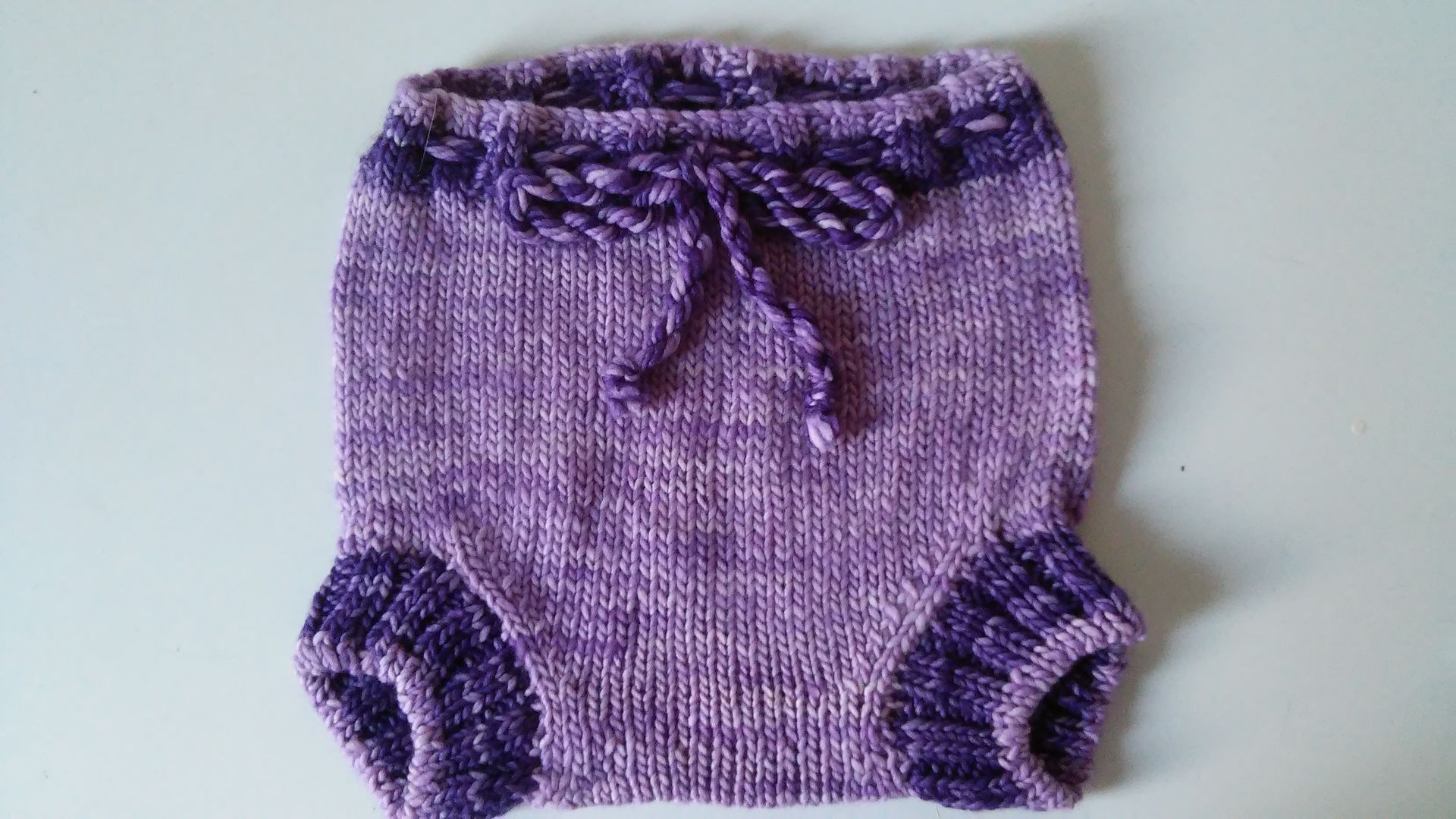
Shorties are more like regular clothes, so are external final garments. You can adapt the cuffs and length of shorties, to vary them.
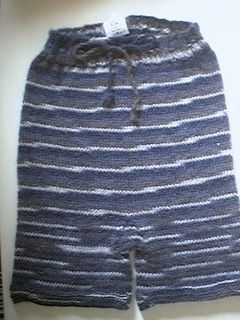
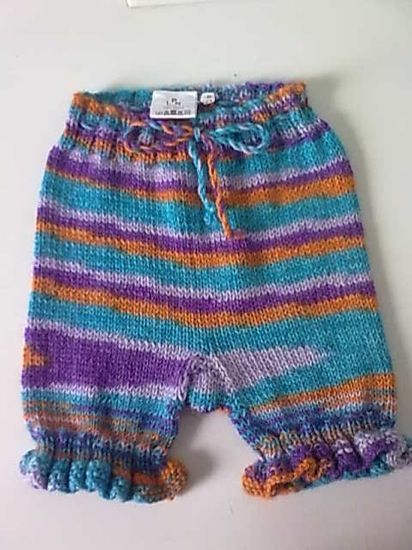
Longies are wool trousers, and again you can adapt the bottoms to make variations.
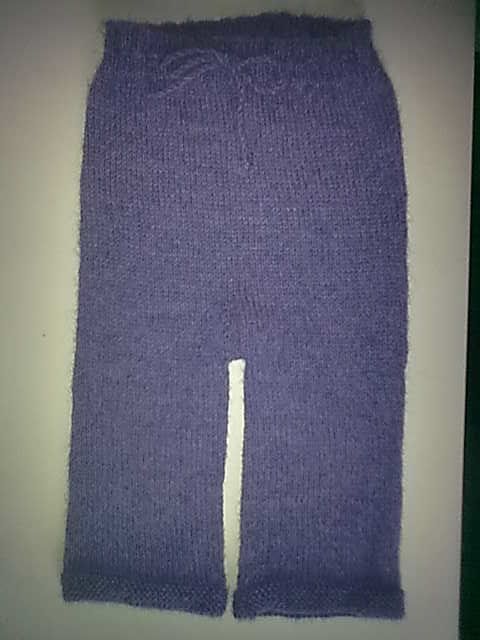
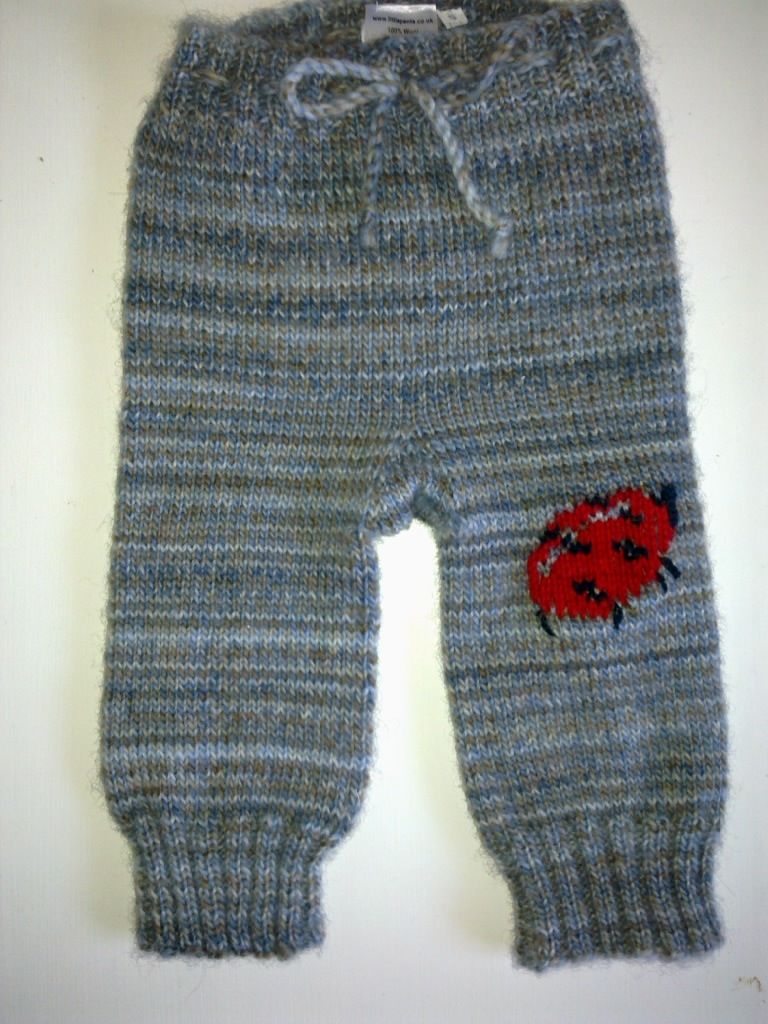
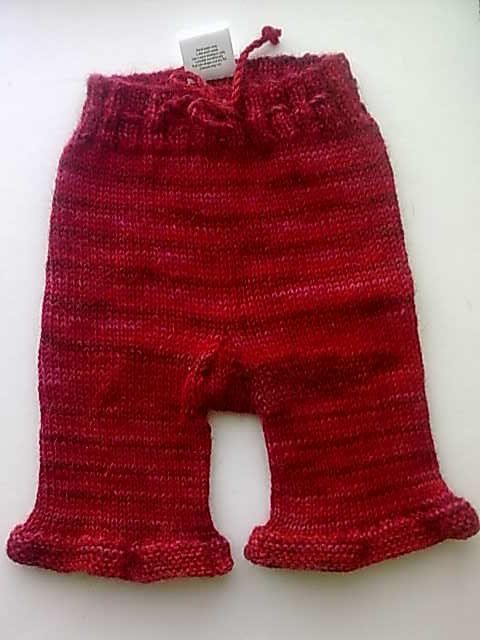
Skirties are for little girls, and usually have an integral soaker. Again they cam [n be adapted into all sorts of beautiful customised designs.
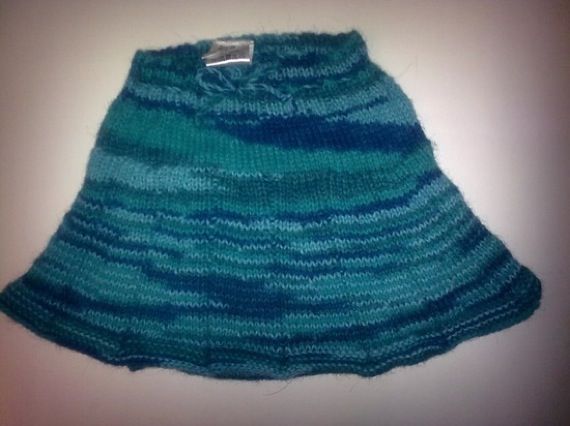

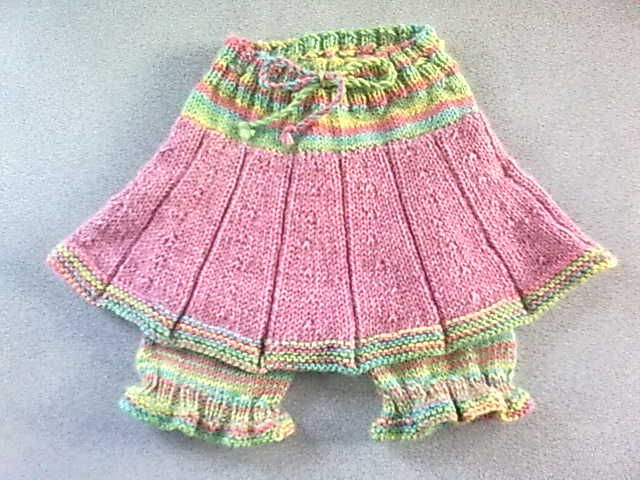
So that's the basics, and enough for one bite!
More coming soon!
How does wool work as a nappy cover?
I'll start with an explanation. Wool is absorbent, but absorbs very slowly. Because of the body heat of your baby, and the warmth of the wool, it also allows moisture to evaporate, and this happens at the same rate as it absorbs, especially if the wool contains a rich concentration of lanolin.
When evaporation takes place, the wet is turned into gasses. Most people think this will be steam, but in fact it's not. Steam is created when evaporated water condenses again, and this happens when the air containing the evaporated gasses, hits something cold, and there is enough wet in it to saturate the air. (This is called the dew point)
If you have a PUL wrap, the inside of the PUL will not let the wet get any further, so the amount of evaporated gasses builds up, and also because PUL has a cold feel, the saturated air will cause wet to condense again, and get absorbed back into the nappy. This doesn't happen with wool, because it is warm, and can breath, so "dew point" is never reached, and the gasses continue one their journey, unrestricted by the wool , baby clothes, bedding etc. It will finally condense possibly when it hits the window of your baby's room in winter, but basically the amount of wet in the air never gets high enough to cause a dew point.
So that is basically how wool works as a nappy cover.
If you can knit or crochet, or know someone who can, it is perfectly possible, and not even difficult, to make your own nappy covers. You do need to make sure you use the right kind of yarn, and bizarrely, it needs to be hand wash yarn. This is because yarns treated to be machine washable have all the natural lanolin removed in the process of making it machine washable. Furthermore, machine washable wool will not absorb lanolin, and lanolin is what works the magic with wool nappy covers. Ideally you need to use 100% wool and/or alpaca.
What can I put over the top?
Well anything can go over the top, as long as it is equally as breathable as the wool, and doesn't squeeze the wool and nappy underneath it. So clothes over the top need to be loose, and preferably natural fibres. us e vest extenders if you want to use a popper vest over a soaker. If you want to use a sleeping bag, that's fine, especially if it a a 100% natural fibre one. Polyester lined sleeping bags work as well, but it may be necessary to leave it open a little, so the air inside can circulate. If your baby's mattress has a waterproof protector on it, then pop a thick bath sheet between the mattress and the bottom sheet, to help aid air circulation. If you've ever slept on a hospital bed with a waterproof protector, you'll probably remember how uncomfortable and sweaty that can feel. Your baby will be much more comfortable with an absorbent layer between him/her and the mattress anyway.
What nappies work best under wool?
Any good absorbent natural fibre nappy works underneath wool. You need to remember though that a wool nappy cover is not a dam. It will absorb, but it won't hold back a flood in an already sodden nappy. So make sure the nappy underneath is up to the job of absorbing for as long as your baby is likely to go between changes. If your baby goes through the night you will probably need to add a bit of extra absorbency. The is because our bladder works differently when we sleep. Think about yourself. During the day you will go to the loo several times during the day, especially if you've drunk any fluids. At night, you will probably not wake at all, but when you do wake in the morning, the first thing you need is to empty your bladder. ie. your bladder wakes up when you do. Your baby is the same. When he/she wakes up there will probably be a bit of a flood - more than a normal day time wee. Even if the nappy underneath is bone dry, a normal daytime nappy may not cope, thus the need for some extra boosting overnight, even if you use a wool cover and the nappy underneath has completely dried since the last wee. The nappy must absorb the wee first for the wool to be able to work its magic.
I have found that still by far the best nappies are good old traditional terry squares. Bamboo terry squares have the additional advantage of being slim fitting, when compared with the same amount of absorbency in say a cotton terry. If you fold 2 terry squares together for an overnight nappy, this will absorb even the biggest flood when your baby wakes. What's more terry squares, even bamboo ones, dry quickly, so it's fantastic solution for overnighting. Fitted overnight nappies can take an age to dry. Another advantage of terry squares is that they are all round, so there is no excessive padding in the so-called 'wet are' which can make fitting clothes over the top difficult. The nappy is going to be wet all around by morning anyway, so all around boosting makes much better sense. Another option to boosting with fitted nappies, is rather than trying to boost one nappy, use a second fitted nappy as an all around booster, instead of booster pads. It doesn't matter if the outer one doesn't fit, or even do up - it will still boost and do a better job that a booster pad.
What's the difference between a soaker and shorties or longies?
A soaker is basically a little pair of wool knickers. It can be used exactly as you would use a PUL wrap. You can use clothes over the top, or in summer just leave it uncovered as a delightful nappy cover init's own right.

Shorties are more like regular clothes, so are external final garments. You can adapt the cuffs and length of shorties, to vary them.


Longies are wool trousers, and again you can adapt the bottoms to make variations.



Skirties are for little girls, and usually have an integral soaker. Again they cam [n be adapted into all sorts of beautiful customised designs.



So that's the basics, and enough for one bite!
More coming soon!

 January 2019
January 2019 May 2010
May 2010